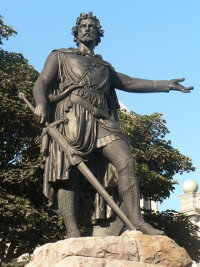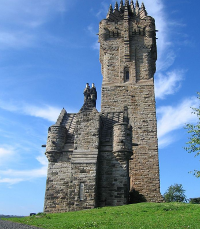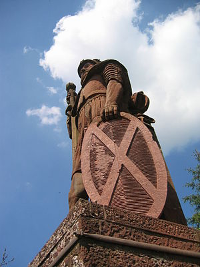William Wallace: Scottish Patriot and Inspiration
William Wallace was a medieval Scotsman who struck back against a foe he regarded as an oppressor, enjoying a meteoric rise and stunning success before meeting his downfall at the hands of his main antagonist. He is a hero in Scotland to this day. 
Not much is known of Wallace's early life. He is known to have been born about 1270 in Elderslie, Renfrewshire. Conflicting sources list his father as either Alan or Malcolm. He is known to have two brothers, Malcolm and John. Details about him emerge in the late 1290s. He is known to have loved and possibly married a woman named Marion Braidfute. Her death, at the hands of the Sheriff of Lanark in 1297, led to Wallace's need for retribution and murder of the sheriff. Wallace and a group of other men burned Lanark in response. Scotland at the time was a loose confederation of clans, led by nobles who competed amongst themselves to have the most influence. The death of King Alexander III in 1286 had left a considerable void, and no one had yet adequately filled that void. The struggle to succeed Alexander as King of Scotland became known as the Great Cause. The Scottish nobles turned to the neighboring monarch to the south, England's King Edward I, to act as kingmaker. The two most powerful nobles in Scotland at the time were John Balliol and Robert Bruce. Edward chose Balliol to be King of the Scots, and Balliol was so crowned. 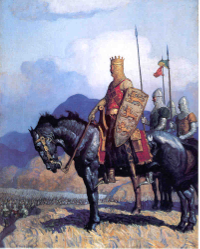
That decision did not sit lightly with the Bruce or his supporters, and dissension simmered. Edward, convinced that the Scottish nobles had appointed him the equivalent of an overlord, made increasingly authoritative demands of Balliol and of Scotland. Edward, fighting against France, demanded that the Scottish nobles provide manpower and money on Edward's behalf. The Scottish nobles refused, instead making an alliance with France (later to be known as the Auld Alliance) and rising up in revolt, launching an attack on Carlisle. An incensed Edward sent an English army into Scotland, in 1296. In the ensuing battle, the Scots proved no match for the English and Edward even seized Balliol, sending him as a prison to the Tower of London. Edward became known as the "Hammer of the Scots." He had destroyed Berwick, taken Dunbar, and seized much of the country and its riches. Also in that year, Edward seized the Stone of Destiny, on which all Scottish kings had been crowned for time immemorial, and sent it to Westminster Abbey. (He later had it installed underneath his Coronation Chair.) Even with this infusion of Scottish money, Edward didn't have enough to build the sort of castle enforcement that he had used to keep Wales in check, and Scotland took advantage. The Scottish rebels rallied behind the leadership of Wallace in the south and Andrew Moray in the north, the former more than the latter, and won a few victories over the English. The most notable of these Scottish victories was at the Battle of Stirling Bridge in 1297. Wallace and Moray had joined forces and were at the River Forth near Stirling in September. The English army, led by John de Warenne, was much larger than the force Wallace ordered his forces to wait until about half of the English force was already across and then attacked. One part of the Scottish force engaged the English soldiers who had already crossed the bridge. One of the first English was the overconfident Cressingham, who had led the charge. Another Scottish force stormed to the bridge, in order to cut off retreat of Englishmen already across and to prevent any further attacks. The English were trapped, encircled, and killed. One English knight, Sir Marmaduke Thweng, made it back across the bridge; the others were caught up in the fray. Warenne, who had stayed behind, ordered the bridge destroyed, trapping the rest of his army in the teeth of slaughter. Many English soldiers escaped by swimming across the Forth. 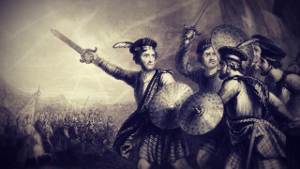
It was a stunning victory for the outnumbered Scots, and Wallace took advantage of the chaos that the victory created by invading northern England, ravaging towns and the surrounding countryside. Also at this time, he was made a knight and was named Sir William Wallace, Guardian of Scotland. Moray was also made Guardian, but he died not long after the victory at Stirling Bridge. Wallace continued to rally the people of Scotland and served as a stand-in for Balliol, who was still out of the way. Edward responded by ordering up another invasion, which began the following April. This force was larger than the last one, featuring 25,000 men in the infantry alone (many Welsh conscripts), accompanied by 1,500 cavalry. The Scots avoided direct contact with the army, trying to harry from afar. As the English army got farther Historians differ on where Wallace was for the next few years, while Edward was solidifying his hold on Scotland and convincing more and more Scottish nobles to recognize his claim as the true king of Scotland. Some sources say that Wallace was in France, trying to enforce the terms of the alliance between his country and that. Wallace, branded an outlaw, returned anyway, in 1304. 
By this time, both of the previous regents, Robert the Bruce and John Comyn, had come to terms with Edward. Wallace did what he could to restore morale, but the time of his influence was gone. He was betrayed by one of his own, Sir John de Menteith, and was arrested, in Glasgow, on August 5, 1305. He was tried and convicted of treason. His defense was that he had never sworn allegiance to Edward as king. Nonetheless, he was brutally executed on August 23. Wallace is remembered as a hero to this day for the role he played in electrifying the Scottish people in their defense against England. Statues of him abound. A very large monument to him still stands near Stirling.
|
|
|||||||||||||||||||||||||||||||
Social Studies for Kids
copyright 2002–2025
David White



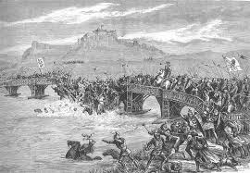 that Wallace and Moray had. Estimates are that the English had up to 10,000 infantry and 3,000 cavalry. One of the English commanders, the former Scottish knight Richard Lundie, urged that a detachment of cavalry be sent to miles upstream to a ford, where 60 horsemen at a time could cross, so that the cavalry could provide an escort for the crossing of the infantry, the main part of the English force and, if possible, outflank the Scottish forces. Hugh de Cressingham, the king's treasurer and tax collector, convinced Warenne that he had already wasted enough of the king's money, and the deployment across the bridge began. To neutralize this numerical superiority, Wallace placed his army on the other side of a bridge that the English would have to cross in order to attack. The bridge was so narrow that only a few men could cross at a time.
that Wallace and Moray had. Estimates are that the English had up to 10,000 infantry and 3,000 cavalry. One of the English commanders, the former Scottish knight Richard Lundie, urged that a detachment of cavalry be sent to miles upstream to a ford, where 60 horsemen at a time could cross, so that the cavalry could provide an escort for the crossing of the infantry, the main part of the English force and, if possible, outflank the Scottish forces. Hugh de Cressingham, the king's treasurer and tax collector, convinced Warenne that he had already wasted enough of the king's money, and the deployment across the bridge began. To neutralize this numerical superiority, Wallace placed his army on the other side of a bridge that the English would have to cross in order to attack. The bridge was so narrow that only a few men could cross at a time.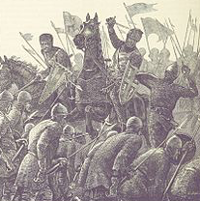 from its supply line, the morale of the soldiers worsened. Edward went on the attack, near Falkirk. This time, the Scots had no geographical strategy to fall back on; the result was
from its supply line, the morale of the soldiers worsened. Edward went on the attack, near Falkirk. This time, the Scots had no geographical strategy to fall back on; the result was 